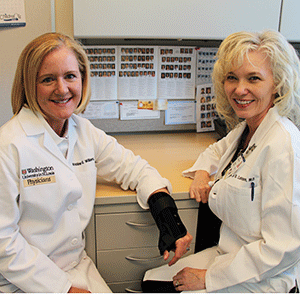
Among the most common pediatric injuries seen in emergency rooms are fractures that occur when children fall and try to catch themselves with an outstretched hand.
For many, that tumble on the playground, around the bases or off a bunk bed results in a “buckle fracture,” a forearm injury traditionally treated with a cast.
But new research from Washington University School of Medicine in St. Louis shows that removable splints are clearly preferred by patients and their parents, building on earlier findings that such splints are just as effective as casts.
“Our goal is to manage these fractures in a manner that allows healing while maximizing comfort and convenience yet minimizing disruptions in children’s active lifestyles,” said senior author Janet D. Luhmann, MD, an associate professor of pediatrics and physician in the emergency department at St. Louis Children’s Hospital. “Traditionally, forearm buckle fractures have been managed with casts, which can be heavy, uncomfortable and, in the summer, hot and cumbersome. Without an expensive liner, children can’t get them wet, which results in significant inconvenience regarding swimming and hygiene.”
The new findings, coupled with earlier research into the effectiveness of splints versus casts, have led to a recent change in the standard treatment of uncomplicated forearm buckle fractures in the emergency department at St. Louis Children’s. Now, prefabricated splints are the chosen treatment.
Further, absent pain experienced by patients, no longer is it recommended that they follow up with orthopedic surgeons and possibly undergo more X-rays. Rather, explained Kristine G. Williams, MD, the study’s lead author, children can be seen by their pediatricians two or three weeks later.
The researchers’ findings are available online in Pediatric Emergency Care.
The recommendations are based on the study’s findings that splints were clearly favored over casts in terms of convenience, satisfaction and preference in the treatment of buckle fractures in children.
A significant percentage of emergency department visits involve children seeking care for orthopedic injuries, said Luhmann. And of these, the most commonly affected area is the forearm, near where the wrist absorbs a fall.
“Buckle fractures are a significant and increasingly common injury in children, likely due in part to increased participation in organized sports,” she said.
The fracture most often occurs in the radius, the bone on the thumb side of the forearm. For that reason, the study’s focus was on radial buckle fractures that occur near the wrist.
Children’s bones, when compared with the bones of adults, are less dense, more porous and more likely to bend than break.
“Because children’s bones are more plastic, they actually can buckle, bend or bow instead of break all the way through,” Luhmann explained. “Kind of like pavement that has sustained too much heat, the bone buckles under too much stress.”
Buckle fractures are inherently stable and are at low risk for displacement and complete breakage, so they tend to heal well with minimal intervention, according to findings in previous studies. The questions researchers set out to answer in this study focused on just how patients and parents felt about two accepted treatment options: casts and splints.
The study took place from April 2006 through May 2009 and involved 94 patients, ages 2 to 17, treated by Washington University physicians at St. Louis Children’s emergency department. The patients were randomly assigned to either short-arm casts or prefabricated wrist splints. They or their parents then were interviewed in the emergency department and again post treatment at days one, three, seven and 21. Areas assessed were satisfaction, convenience, preference and pain.
The findings showed a clear trend favoring splints at almost every period throughout the study. The only exception noted involved pain experienced by patients immediately after receiving splints or casts, before discharge from the emergency department. Those in the splinted group reported a higher incidence of pain at that stage, though the difference was not statistically significant.
The findings, Williams and Luhmann said, show that when treating uncomplicated buckle fractures near the wrist, splints are preferred by patients and their parents — in addition to the fact they are easier, less time-consuming and less expensive to apply than casts.
‘’We found very clearly that over the entire study period, parents rated the splint higher in almost all categories,” said Williams, an assistant professor of pediatrics who treats patients in St. Louis Children’s emergency department. “They tended to say they would definitely choose the splint again over a cast if they had a similar kind of injury.”
In the event a health professional recommends a cast for a child who suffers a forearm buckle fracture, Williams suggests that the parent request a splint, based on the study’s findings.
Williams KG, Smith G, Luhmann SJ, Mao J, Gunn III JD, Luhmann JD. A randomized controlled trial of cast versus splint for distal radial buckle fracture. Pediatric Emergency Care. May 2013.
Washington University School of Medicine’s 2,100 employed and volunteer faculty physicians also are the medical staff of Barnes-Jewish and St. Louis Children’s hospitals. The School of Medicine is one of the leading medical research, teaching and patient care institutions in the nation, currently ranked sixth in the nation by U.S. News & World Report. Through its affiliations with Barnes-Jewish and St. Louis Children’s hospitals, the School of Medicine is linked to BJC HealthCare.
